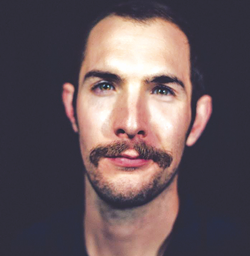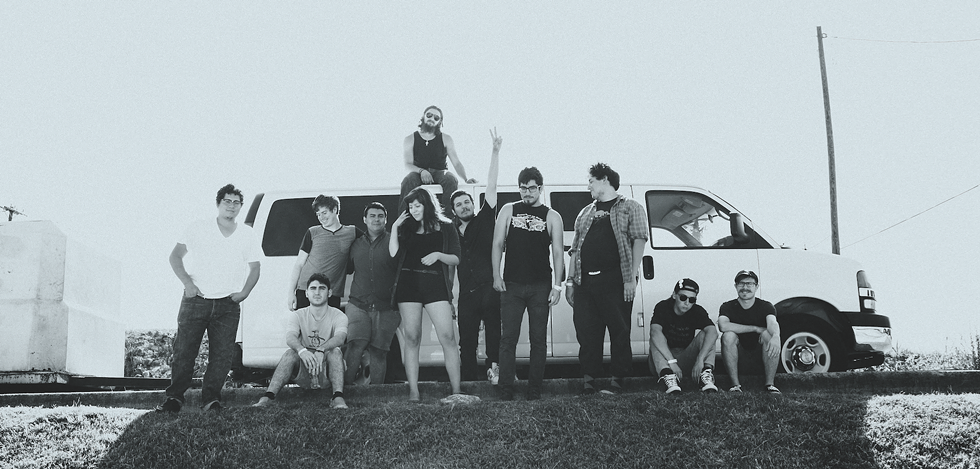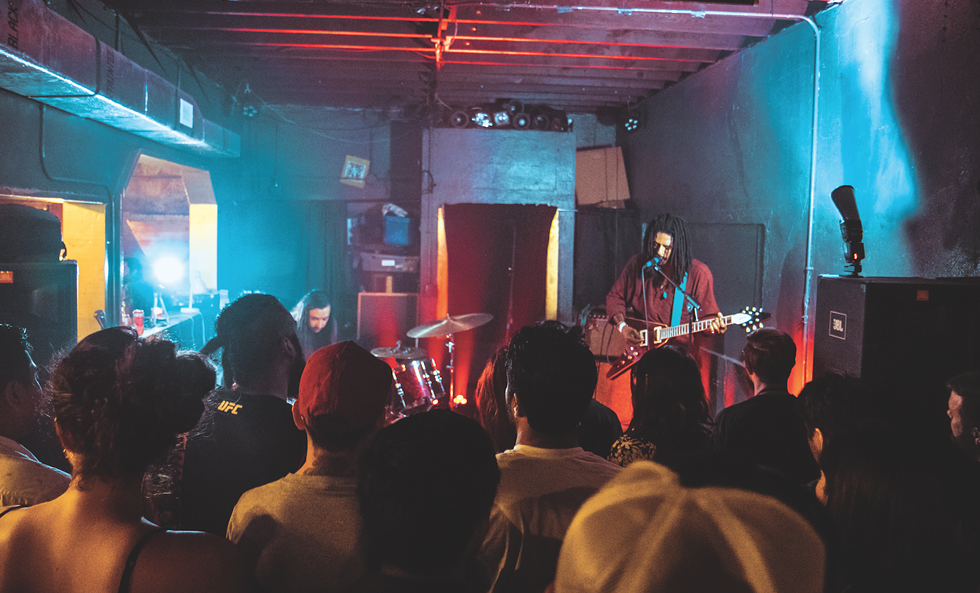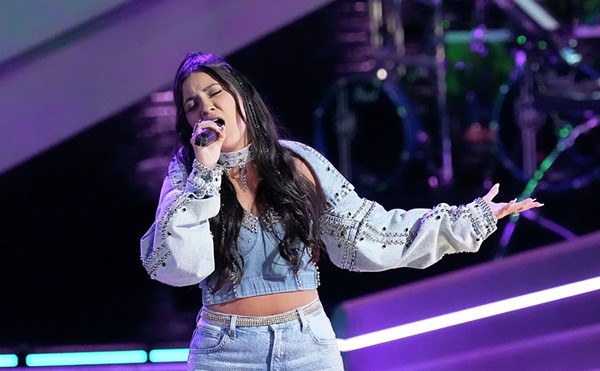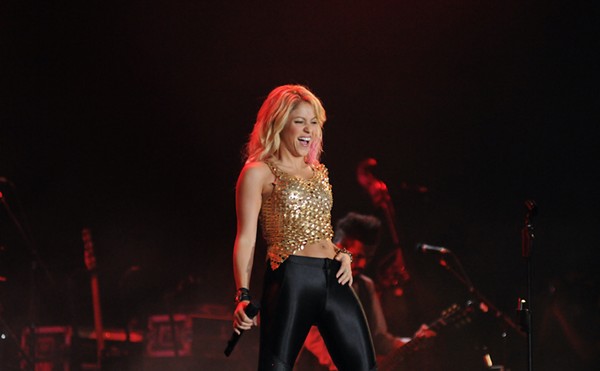At 31, Alonzo is a well-known name on San Antonio’s indie-music circuit. From ripping a heartfelt set at Maverick Music Festival in 2016 to the standing ovation for her cover of Radiohead’s “Lucky” with the youth orchestra YOSA at the Tobin Center for the Performing Arts, she’s proved to be an artist on the rise.
But despite consistent gigging – from corporate events to music festivals and local shows – Alonzo still needs to hold down another job to make ends meet. That’s why, this Tuesday night, the soulful siren isn’t sticking around ‘til last call. She’s a supervisor for a pest control company and has to be at work at 5 a.m.
Alonzo’s style and stage presence are unique, but her struggle to both perform and pay the bills is common to many of San Antonio’s musicians. A recent city-commissioned study showed that 80 percent of local music professionals earn most of their income from work outside of music. That means your favorite San Antonio artists most likely also rock day jobs, and not by choice.
The goal of the report, conducted by the nonprofit San Antonio Sound Garden, was to evaluate the state of the music industry and to see what it would take to grow San Antonio’s music economy, how to make it more attractive to outside industry professionals, and how much heavy lifting is required to get there. The study also evaluated current city policies that impact music, and what role the city’s Arts and Culture Department should play.
But based on conversations with local musicians trying to make a living playing music, there’s probably not a lot city government can do to strengthen the scene.
For her part, Alonzo’s attention is on club owners.
“I wish some of the venues that book national artists would pay local artists a little bit better,” Alonzo said. While she understands that some of the national acts coming through the Alamo City have their own payment guarantees, the singer is frustrated that the payout for locals isn’t more. “I just wish more people would honor the guarantee, you know? My guarantee isn’t ridiculous, and I do bring out a crowd, so I just don’t know why people have a problem honoring it.”
Talk with enough San Antonio musicians, and you’re likely to hear the same concern.
But performers and promoters I interviewed also said a lot of musicians have to get their acts together before they can expect to earn bigger paydays.
How much venue owners pay performers depends partly on whether they have a talent budget or pay out a percentage of bar sales, according to Libby Day, director of operations at SATX Music, an independent media and event-management company that books shows and promotes local artists. But part of it also comes down to how hard a band has worked to build a following. How many fans do they have who are willing to pay at the door to see their band for the umpteenth time?
Day, who is also the marketing manager at Aztec Theatre, believes only a small number of bands put enough effort into promoting their music and live shows. One or two posts on social media won’t cut it.
“There’s two ways people can look at it,” she said. “Do you want to take success into your own hands and be responsible for selling your product and getting people to invest their time and their money in what you love to do? Or do you want to be at the mercy of promoters and venues, and say, ‘Hey, we’d really like to make a hundred bucks tonight.’ OK, cool. What the fuck are you gonna do to make that happen?”
Even more basic than beefing up their self-promotion, a lot of acts have to work harder at perfecting their music and live performances.
Honky-tonk musician Garrett T. Capps said he’d like to see more music venues that have an actual stage and professional production, including good lights and sound. But just as importantly, musicians should focus on recording and releasing music that meets higher industry standards. Bands need to start releasing better quality recordings, in addition to learning how to properly market their music.
“I realize this has to come before we get more music venues and more music fans,” said Capps, who also works as a production manager for World Audio & Lights, a production company that works corporate conventions and events in San Antonio and around the U.S.
Capps isn’t the only one who feels that bands need to be held to a higher standard in SA. Jeannette Muñiz, host of KRTU’s Live and Local segment on the station’s Indie Overnight program, said bands need to take the initiative. In addition to taking their music seriously, they should treat it like a business if they want to be successful.
“If this is a passion, then you will succeed,” she said. “If you’re just doing this as a hobby, don’t bother [trying to become a success], because music is brutal, music is honest, it will kill you, or it’ll give you everything you’ve ever wanted. But you have to give it everything you have before you get anything back.”
Muñiz, who is also a local musician and promoter, said bands should learn from established artists.
“We need to [hold] musicians to a basic music industry standard that other cities are implementing just to hire a band,” she said, noting that she requires bands that want to come on her program to have an electronic press kit.
Phanie Diaz, of Girl in a Coma and Fea fame, said new bands should take whatever gig they can when starting out. At least that’s what she did when Girl in a Coma began playing shows. The drummer also co-owns the Bang Bang Bar and books performers regularly, so she’s no stranger to the mistakes a lot of fresh-out-the-garage bands make.
“It boggles my brain,” Diaz said. “I see a lot of bands that don’t want to work for [success], and we had to work for it. That’s how we got our name out. Don’t act like a rock star. If it’s easy, you’re doing it wrong.”
To Jonny Hawkins of San Antonio’s Nothing More, recently nominated for three Grammys, it’s all about the grind.
“Most of the time our heads are down, and even if we’re getting charting positions, we’re like, ‘Cool. Alright, what’s next? What are we working on? How do we keep moving the ball forward?’” Hawkins said. “The only thing that builds your following and career is just focusing on building your own fan base and not trying to – the shortcuts really don’t work.”
Hawkins and his band have been paying their dues on the local San Antonio live-music circuit since 2003, playing places like Jack’s and Paper Tiger as well as touring nationally.
In January, the Texas Music Office, a division of the governor’s office, named San Antonio a “Music Friendly Community,” making it the fourth Texas city to win the designation alongside Fort Worth, Austin and Denton. The TMO developed this program to highlight opportunities in each city’s local music industry, share information between the office and music-friendly communities and figure out how to best market each city’s musical offerings to the rest of the world.
Over the next few months, the Department of Arts and Culture and the San Antonio Arts Commission’s Music Committee will work with the TMO and local performers to develop a “Music Strategic Plan” for the city of San Antonio. The plan is expected to be presented to city council in June.
While this sounds promising, we’re not exactly sure what it all means, or what we can expect to see as a result, or when there will be any kind of improvement.
And what about music festivals in San Antonio? Do they actually bolster our music industry? How about the overall economy?
Graham Weston, co-founder and former chairman of Rackspace, seems to think so.
He and one-time Rackspace President Lew Moorman helped finance a new music festival dubbed Botánica Music and Arts Festival, which featured acts such as Deftones, Lil Yachty, Logic and a few San Antonio bands. But organizers had to scale back the event, which was originally set for the Six Flags Fiesta Texas parking lot on March 3 and 4, to one day. They also lost headliners Major Lazer, Blackbear and Brett Young. To make up for the shortened schedule, the folks behind the fest granted ticket buyers full access to the park and added more artists.
“Other cities have clearly benefited from large, locally owned, mainstream music fests,” Weston said in a news release. “And our hope is that Botánica can be that kind of festival for San Antonio.
“I know firsthand from my years at Rackspace that our city is in a tough battle for young talent,” Weston said. “Young people often decide where to locate based on lifestyle choices, and shared music experiences can be a big part of that.”
Festival organizers plan to bring Botánica back in 2019, according to their website.
While this sounds like what Maverick Music Festival had already been doing – hosting a mix of national acts and local musicians and artists since 2013 – Maverick isn’t returning this April, said organizer Faith Radle.
Femina-X frontwoman Daniela Riojas, who performed at Botánica – she’s also is a full-time photographer – said she believes the festival will be beneficial to the local music economy.
“Yes, there’s the push and pull of us feeling like we’re being gentrified or our culture’s being taken from us and appropriated and used for commercial reasons,” Riojas said, referring to the use of “Botánica” in the event’s title. “At the same time, we also see a lack in our music economy and that artists are having a difficult time with the day-to-day gigs, having enough funding for music videos and getting ahead in their career.”
A weak music-festival scene, not always shooting for higher standards, not enough attention to self-promotion – these all factor into keeping ours a part-time music industry.
But there’s still another big challenge. Even with all the sponsored social-media ads, street-teaming and Facebook event invites, if San Antonio audiences don’t start valuing and championing our own musicians, I doubt we’ll see much of a change.
“If our community, just in their language, can talk about people and talk about how good the art is, [this] could create a culture of awareness [about the San Antonio music scene],” said Edwin Stephens, who’s played in several successful indie projects over the years, including Blowing Trees and Fishermen. He’s also a founder of San Antonio Sound Garden, and bounces between recording and producing local musicians, performing his own music, and working with a copywriting firm.
“San Antonio needs to be branded as a music city, but I think part of that – an even more important part of that – is the organic grassroots aspect of that, which means the community, at a grassroots level, needs to own the fact that we have an incredible music scene and incredible talent here. That needs to become part of our dialogue.”
This may seem obvious, but most of the local musicians and artists you see playing around San Antonio didn’t just all-of-a-sudden start rocking concerts on the St. Mary’s Strip. Most have spent years fine-tuning their craft and their live performances. And that’s what you’re paying for: the experience, the memory, the way the music made you feel, the thing that stays with you after you leave the venue. That has value, and it’s totally worth your money.
“The creative class often has this conundrum that most vocations don’t – having to offer their art for less [than what it’s worth],” said Adam Tutor, who’s the community outreach director for San Antonio Sound Garden, teen outreach specialist for the San Antonio Public Library and a local musician. “There are those things that go into that conversation as an artist that a great deal of the population doesn’t know about.”
Michael Christopher Garcia, who’s featured on this week’s cover and plays in the local band RMRS, said he would like to see more people paying attention at concerts and not being distracted by their phones or bar tabs.
“You’re gonna make a musician so much happier [watching them play] rather than taking their fucking video,” Garcia said. “Listen to what people are playing. Don’t worry about the line at the bar, or closing out [a tab]. Don’t worry about what you’re gonna tweet.”
Garcia is the director of technology at the Denver office of WeWork, which builds community office spaces. But he still performs in San Antonio. The musician said moving to Denver last October (he said he’ll be coming back to Texas soon) was as an opportunity to see what music scenes were like in other cities. He’s concluded there’s a strong music community in the greater San Antonio-Austin bubble.
“At first, I was really stoked to leave,” Garcia said. But after a while he started to appreciate all that Texas had to offer. “A lot of it is the people, that family-oriented mindset that people have that really helps you in succeeding and believing in yourself.”
Garcia and his band recently played with other local acts Deer Vibes, fronted by Michael Carillo, who owns the music venue Ventura, and Lonely Horse, whose drummer, Travis Hild, is a woodworker during the day and barbacks part-time at night at Barbaro. These bands have been active on the scene for over a decade, but almost all of their members still have to hold down day jobs. That says a lot.
In our 300th year as a city, our music economy is probably as strong as ever, but we still need to push for full-time status. It’ll take a lot of work and the continued dedication of everyone who’s striving to strengthen the scene today. The aim is to make San Antonio a place for up-and-comers to grow and for veteran acts to thrive between tours.
Stay on top of San Antonio news and views. Sign up for our Weekly Headlines Newsletter.



